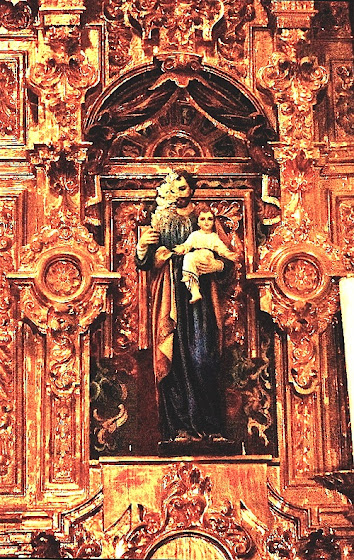Our next couple of posts will focus on churches of note in Aguascalientes, the city and its hinterland, not already covered in our blog:
The church was completed by 1750, and a grand retablo mayor was installed, designed and constructed by Juan Garcia de Castañeda in the celebrated Ureña Aguascalientes workshop.
Although there have been some later changes, most obviously in the center pavilion and possibly the upper pediment, the retablo bears key features associated with the felipense style. Narrow estípites, emblazoned with the signature “winged circle” motif and headed by opulent, elongate Composite capitals, frame the curtained sculpture niches on either side.
It is possible that this sumptuous work may, in fact, be one of
the altarpieces originally created by the Ureñas and García de Castañeda for the cathedral in the city of
Aguascalientes—one that was dedicated to San José and later reportedly destroyed. The
statue of St. Joseph is especially fine, giving weight to the story.!
text © 2023 Richard D. Perry. Images courtesy of Nick Brooker and online sources.
look for our forthcoming story of Felipe de Ureña and ghis family
Known as El maestro transhumante, the "peripatetic master", Felipe de Ureña was the most influential of the Mexican born architect /designers to introduce and expand the Churrigueresque or barroco estípite style into New Spain. During the second half of the 18th century, together with family members, he was primarily responsible for the spread and subsequent evolution of this ornate late baroque style into cities across Mexico, especially along the silver routes north of Mexico City. Primarily an innovative designer and fabricator of altarpieces, he later adapted the barroco estípite style as it was called, for church facades. His elegant and distinctive designs are recognized as the "felipense" style.
View these links to some other Ureña altarpieces: Rayas Chapel; Aguascalientes; Cata; La Valenciana;





No comments:
Post a Comment